Report: Emerging Issues in Current Oil and Gas Business Management
VerifiedAdded on 2023/06/13
|15
|4159
|211
Report
AI Summary
This report delves into the emerging issues impacting strategic decision-making in the oil and gas industry. It examines themes such as natural resources, technological advancements, urbanization, labor markets, and the evolution of global financial markets. The report analyzes how these factors, along with political environments, demographic changes, social trends, legal transformations, and global economic issues, influence the strategic planning and decision-making processes within oil and gas companies. It further explores the impact of technology on resource utilization, the effects of urbanization on market strategies, and the dynamics of labor markets in the energy sector, providing a comprehensive overview of the challenges and opportunities facing the industry.
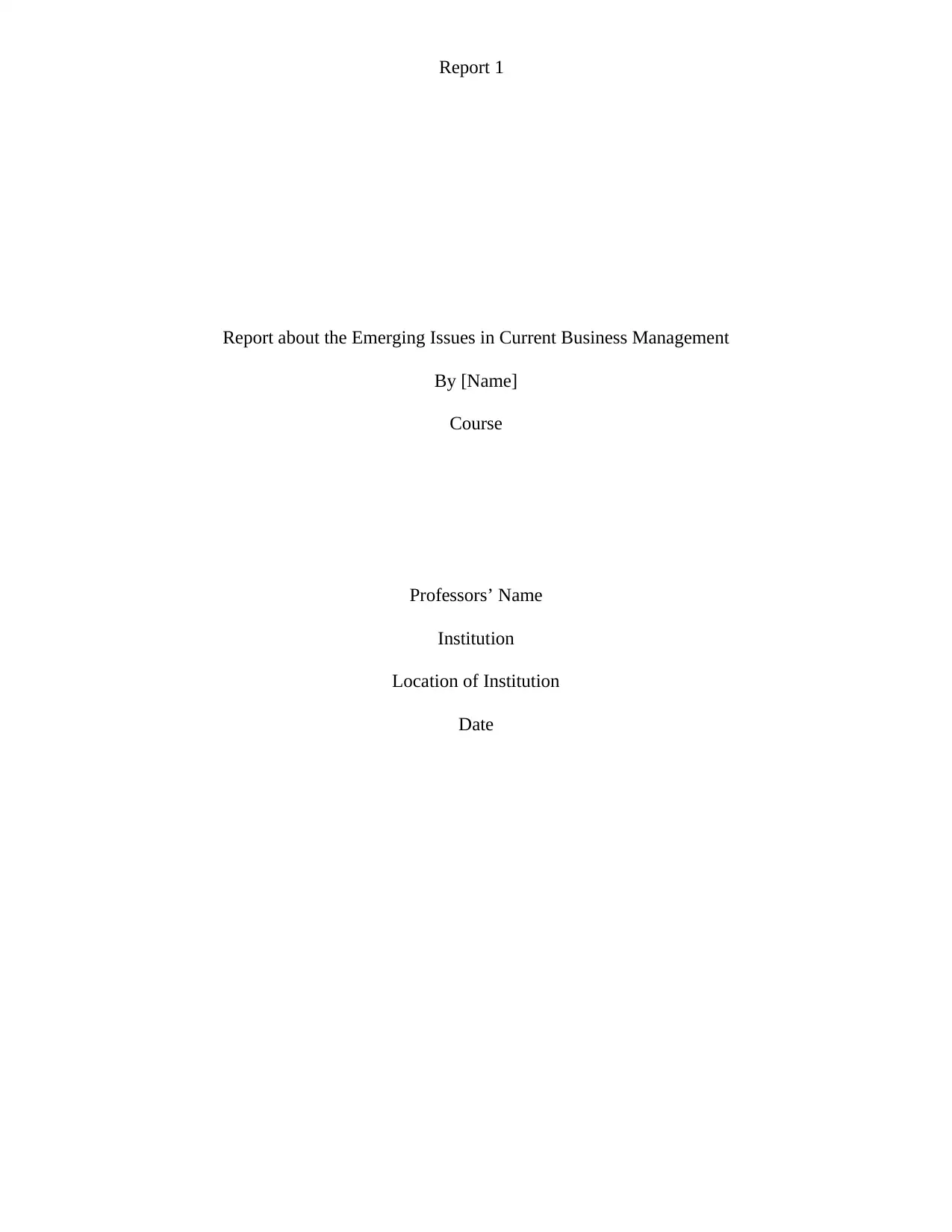
Report 1
Report about the Emerging Issues in Current Business Management
By [Name]
Course
Professors’ Name
Institution
Location of Institution
Date
Report about the Emerging Issues in Current Business Management
By [Name]
Course
Professors’ Name
Institution
Location of Institution
Date
Paraphrase This Document
Need a fresh take? Get an instant paraphrase of this document with our AI Paraphraser
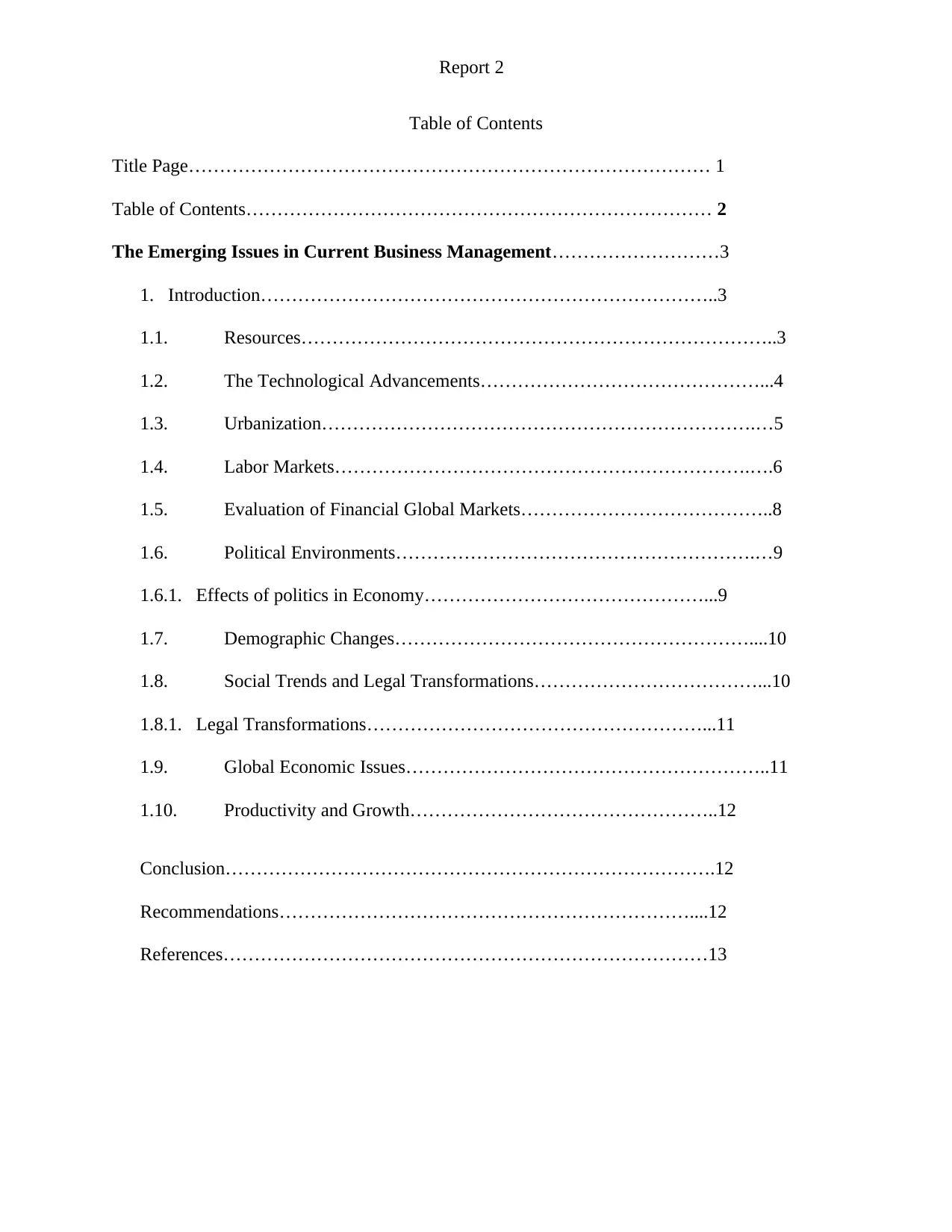
Report 2
Table of Contents
Title Page………………………………………………………………………… 1
Table of Contents………………………………………………………………… 2
The Emerging Issues in Current Business Management………………………3
1. Introduction………………………………………………………………..3
1.1. Resources…………………………………………………………………..3
1.2. The Technological Advancements………………………………………...4
1.3. Urbanization…………………………………………………………….…5
1.4. Labor Markets………………………………………………………….….6
1.5. Evaluation of Financial Global Markets…………………………………..8
1.6. Political Environments………………………………………………….…9
1.6.1. Effects of politics in Economy………………………………………...9
1.7. Demographic Changes…………………………………………………....10
1.8. Social Trends and Legal Transformations………………………………...10
1.8.1. Legal Transformations………………………………………………...11
1.9. Global Economic Issues…………………………………………………..11
1.10. Productivity and Growth…………………………………………..12
Conclusion…………………………………………………………………….12
Recommendations…………………………………………………………....12
References……………………………………………………………………13
Table of Contents
Title Page………………………………………………………………………… 1
Table of Contents………………………………………………………………… 2
The Emerging Issues in Current Business Management………………………3
1. Introduction………………………………………………………………..3
1.1. Resources…………………………………………………………………..3
1.2. The Technological Advancements………………………………………...4
1.3. Urbanization…………………………………………………………….…5
1.4. Labor Markets………………………………………………………….….6
1.5. Evaluation of Financial Global Markets…………………………………..8
1.6. Political Environments………………………………………………….…9
1.6.1. Effects of politics in Economy………………………………………...9
1.7. Demographic Changes…………………………………………………....10
1.8. Social Trends and Legal Transformations………………………………...10
1.8.1. Legal Transformations………………………………………………...11
1.9. Global Economic Issues…………………………………………………..11
1.10. Productivity and Growth…………………………………………..12
Conclusion…………………………………………………………………….12
Recommendations…………………………………………………………....12
References……………………………………………………………………13
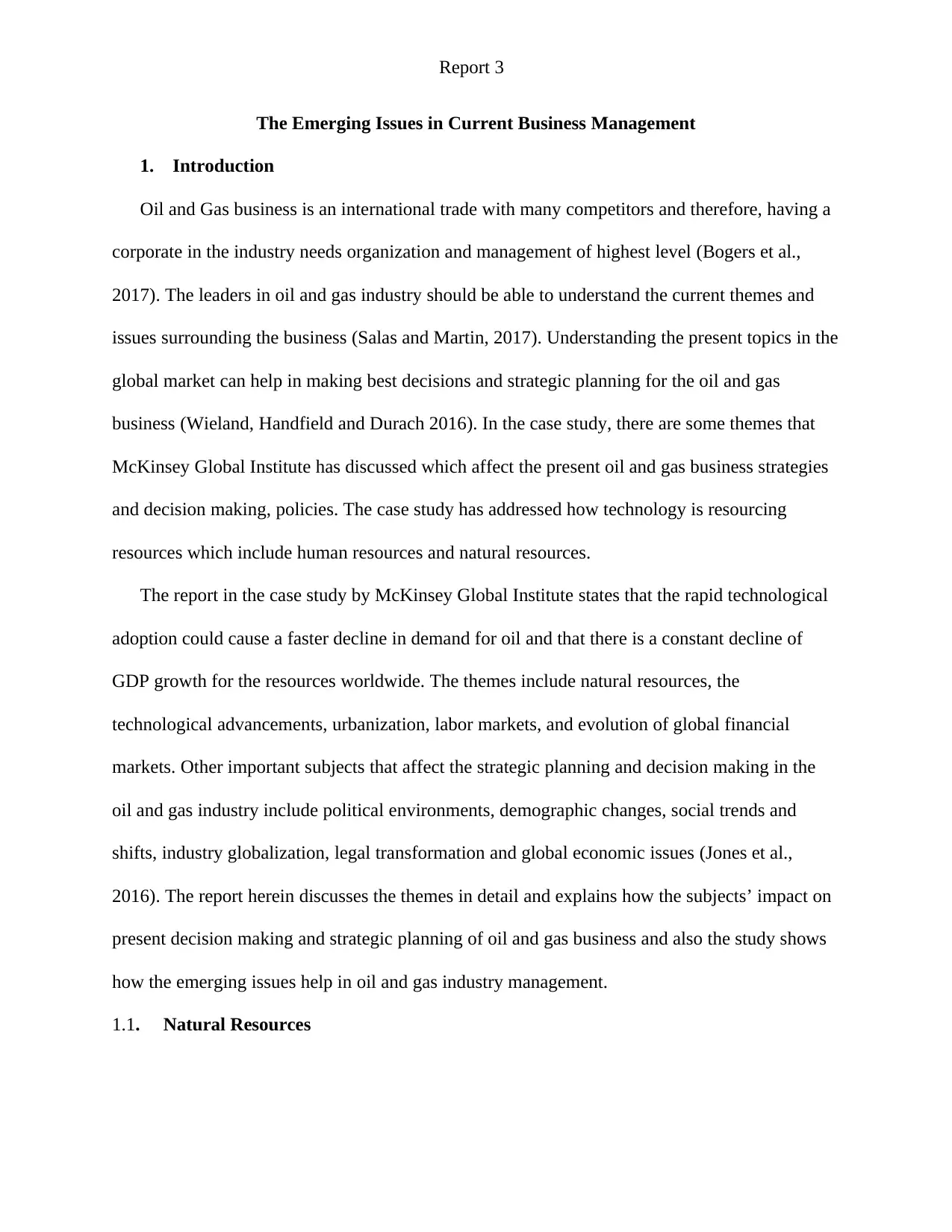
Report 3
The Emerging Issues in Current Business Management
1. Introduction
Oil and Gas business is an international trade with many competitors and therefore, having a
corporate in the industry needs organization and management of highest level (Bogers et al.,
2017). The leaders in oil and gas industry should be able to understand the current themes and
issues surrounding the business (Salas and Martin, 2017). Understanding the present topics in the
global market can help in making best decisions and strategic planning for the oil and gas
business (Wieland, Handfield and Durach 2016). In the case study, there are some themes that
McKinsey Global Institute has discussed which affect the present oil and gas business strategies
and decision making, policies. The case study has addressed how technology is resourcing
resources which include human resources and natural resources.
The report in the case study by McKinsey Global Institute states that the rapid technological
adoption could cause a faster decline in demand for oil and that there is a constant decline of
GDP growth for the resources worldwide. The themes include natural resources, the
technological advancements, urbanization, labor markets, and evolution of global financial
markets. Other important subjects that affect the strategic planning and decision making in the
oil and gas industry include political environments, demographic changes, social trends and
shifts, industry globalization, legal transformation and global economic issues (Jones et al.,
2016). The report herein discusses the themes in detail and explains how the subjects’ impact on
present decision making and strategic planning of oil and gas business and also the study shows
how the emerging issues help in oil and gas industry management.
1.1. Natural Resources
The Emerging Issues in Current Business Management
1. Introduction
Oil and Gas business is an international trade with many competitors and therefore, having a
corporate in the industry needs organization and management of highest level (Bogers et al.,
2017). The leaders in oil and gas industry should be able to understand the current themes and
issues surrounding the business (Salas and Martin, 2017). Understanding the present topics in the
global market can help in making best decisions and strategic planning for the oil and gas
business (Wieland, Handfield and Durach 2016). In the case study, there are some themes that
McKinsey Global Institute has discussed which affect the present oil and gas business strategies
and decision making, policies. The case study has addressed how technology is resourcing
resources which include human resources and natural resources.
The report in the case study by McKinsey Global Institute states that the rapid technological
adoption could cause a faster decline in demand for oil and that there is a constant decline of
GDP growth for the resources worldwide. The themes include natural resources, the
technological advancements, urbanization, labor markets, and evolution of global financial
markets. Other important subjects that affect the strategic planning and decision making in the
oil and gas industry include political environments, demographic changes, social trends and
shifts, industry globalization, legal transformation and global economic issues (Jones et al.,
2016). The report herein discusses the themes in detail and explains how the subjects’ impact on
present decision making and strategic planning of oil and gas business and also the study shows
how the emerging issues help in oil and gas industry management.
1.1. Natural Resources
⊘ This is a preview!⊘
Do you want full access?
Subscribe today to unlock all pages.

Trusted by 1+ million students worldwide
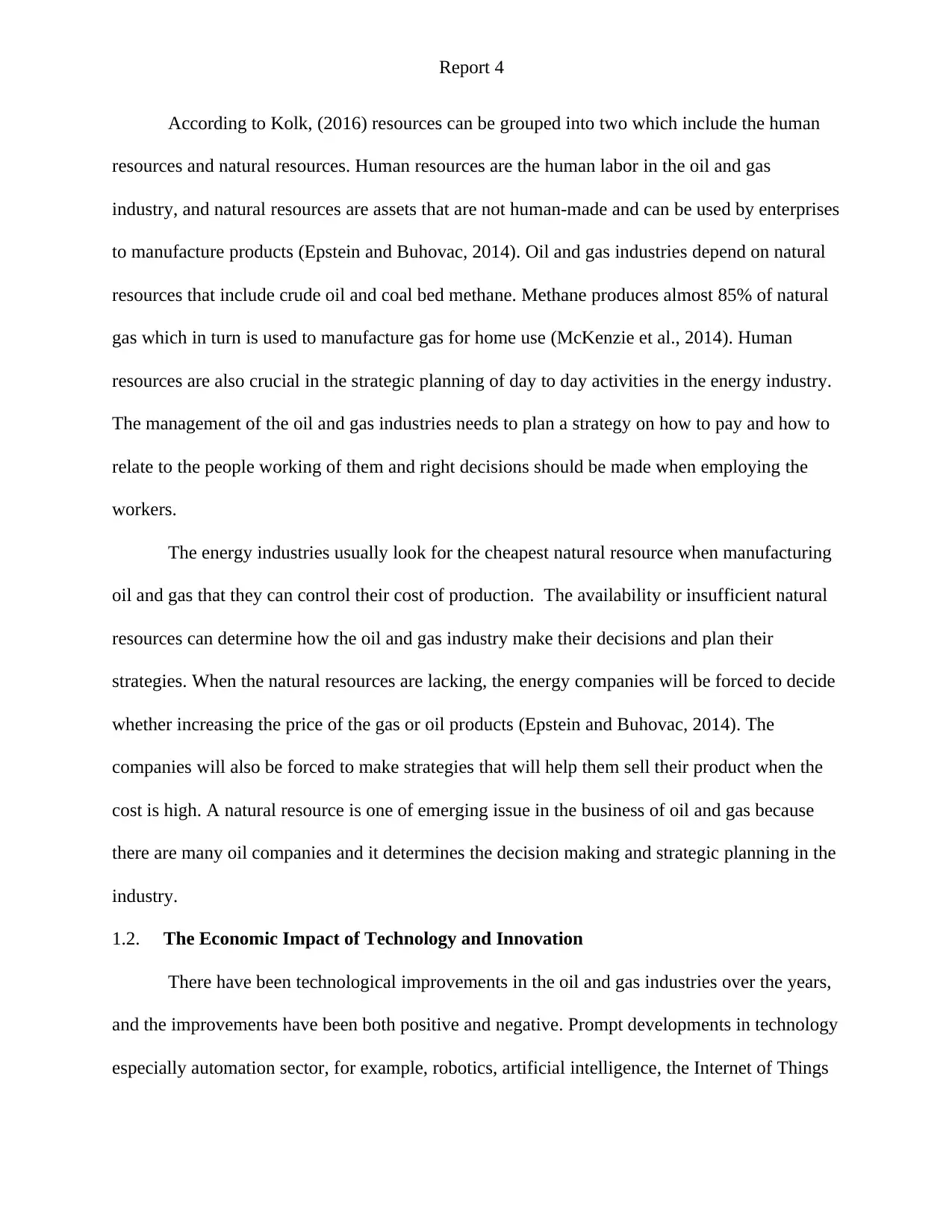
Report 4
According to Kolk, (2016) resources can be grouped into two which include the human
resources and natural resources. Human resources are the human labor in the oil and gas
industry, and natural resources are assets that are not human-made and can be used by enterprises
to manufacture products (Epstein and Buhovac, 2014). Oil and gas industries depend on natural
resources that include crude oil and coal bed methane. Methane produces almost 85% of natural
gas which in turn is used to manufacture gas for home use (McKenzie et al., 2014). Human
resources are also crucial in the strategic planning of day to day activities in the energy industry.
The management of the oil and gas industries needs to plan a strategy on how to pay and how to
relate to the people working of them and right decisions should be made when employing the
workers.
The energy industries usually look for the cheapest natural resource when manufacturing
oil and gas that they can control their cost of production. The availability or insufficient natural
resources can determine how the oil and gas industry make their decisions and plan their
strategies. When the natural resources are lacking, the energy companies will be forced to decide
whether increasing the price of the gas or oil products (Epstein and Buhovac, 2014). The
companies will also be forced to make strategies that will help them sell their product when the
cost is high. A natural resource is one of emerging issue in the business of oil and gas because
there are many oil companies and it determines the decision making and strategic planning in the
industry.
1.2. The Economic Impact of Technology and Innovation
There have been technological improvements in the oil and gas industries over the years,
and the improvements have been both positive and negative. Prompt developments in technology
especially automation sector, for example, robotics, artificial intelligence, the Internet of Things
According to Kolk, (2016) resources can be grouped into two which include the human
resources and natural resources. Human resources are the human labor in the oil and gas
industry, and natural resources are assets that are not human-made and can be used by enterprises
to manufacture products (Epstein and Buhovac, 2014). Oil and gas industries depend on natural
resources that include crude oil and coal bed methane. Methane produces almost 85% of natural
gas which in turn is used to manufacture gas for home use (McKenzie et al., 2014). Human
resources are also crucial in the strategic planning of day to day activities in the energy industry.
The management of the oil and gas industries needs to plan a strategy on how to pay and how to
relate to the people working of them and right decisions should be made when employing the
workers.
The energy industries usually look for the cheapest natural resource when manufacturing
oil and gas that they can control their cost of production. The availability or insufficient natural
resources can determine how the oil and gas industry make their decisions and plan their
strategies. When the natural resources are lacking, the energy companies will be forced to decide
whether increasing the price of the gas or oil products (Epstein and Buhovac, 2014). The
companies will also be forced to make strategies that will help them sell their product when the
cost is high. A natural resource is one of emerging issue in the business of oil and gas because
there are many oil companies and it determines the decision making and strategic planning in the
industry.
1.2. The Economic Impact of Technology and Innovation
There have been technological improvements in the oil and gas industries over the years,
and the improvements have been both positive and negative. Prompt developments in technology
especially automation sector, for example, robotics, artificial intelligence, the Internet of Things
Paraphrase This Document
Need a fresh take? Get an instant paraphrase of this document with our AI Paraphraser
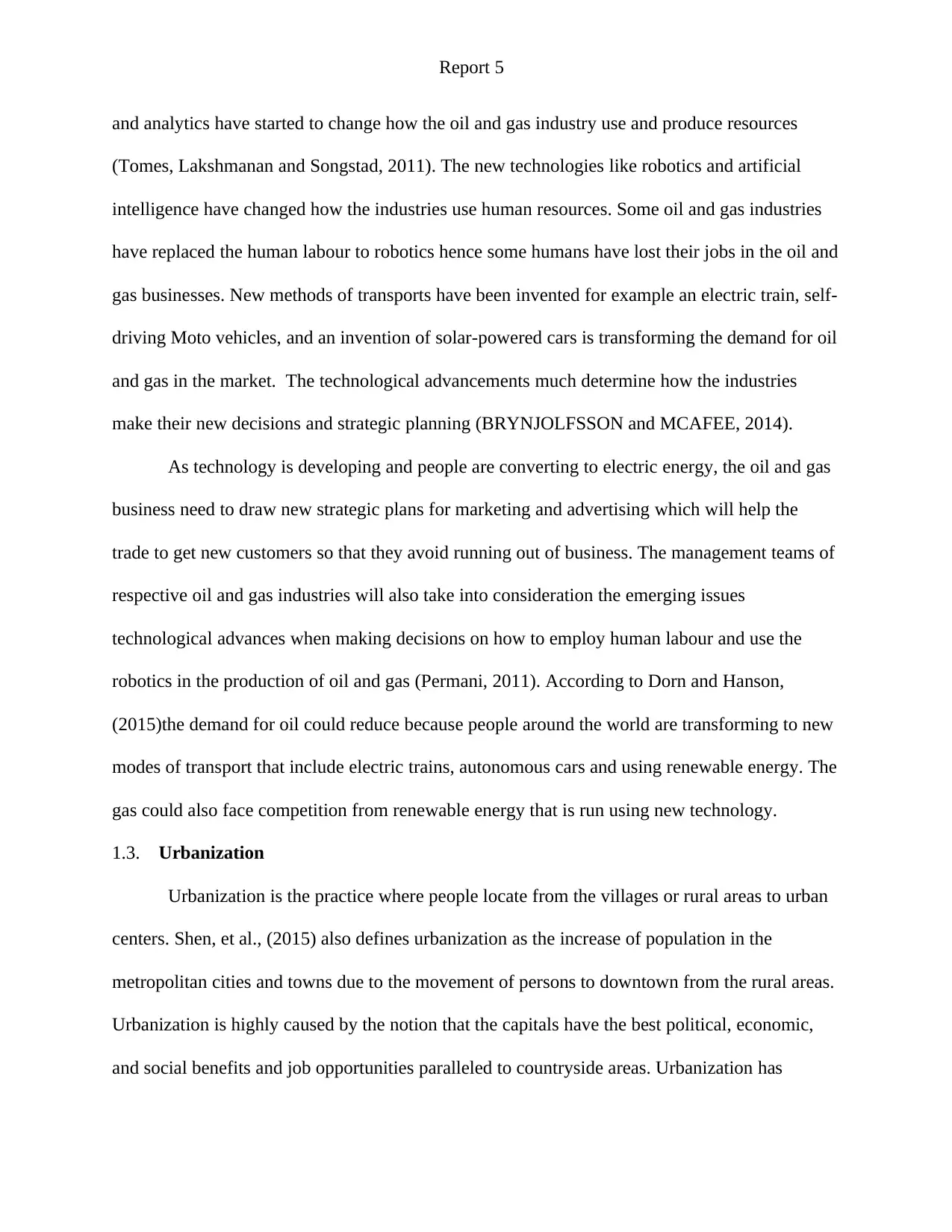
Report 5
and analytics have started to change how the oil and gas industry use and produce resources
(Tomes, Lakshmanan and Songstad, 2011). The new technologies like robotics and artificial
intelligence have changed how the industries use human resources. Some oil and gas industries
have replaced the human labour to robotics hence some humans have lost their jobs in the oil and
gas businesses. New methods of transports have been invented for example an electric train, self-
driving Moto vehicles, and an invention of solar-powered cars is transforming the demand for oil
and gas in the market. The technological advancements much determine how the industries
make their new decisions and strategic planning (BRYNJOLFSSON and MCAFEE, 2014).
As technology is developing and people are converting to electric energy, the oil and gas
business need to draw new strategic plans for marketing and advertising which will help the
trade to get new customers so that they avoid running out of business. The management teams of
respective oil and gas industries will also take into consideration the emerging issues
technological advances when making decisions on how to employ human labour and use the
robotics in the production of oil and gas (Permani, 2011). According to Dorn and Hanson,
(2015)the demand for oil could reduce because people around the world are transforming to new
modes of transport that include electric trains, autonomous cars and using renewable energy. The
gas could also face competition from renewable energy that is run using new technology.
1.3. Urbanization
Urbanization is the practice where people locate from the villages or rural areas to urban
centers. Shen, et al., (2015) also defines urbanization as the increase of population in the
metropolitan cities and towns due to the movement of persons to downtown from the rural areas.
Urbanization is highly caused by the notion that the capitals have the best political, economic,
and social benefits and job opportunities paralleled to countryside areas. Urbanization has
and analytics have started to change how the oil and gas industry use and produce resources
(Tomes, Lakshmanan and Songstad, 2011). The new technologies like robotics and artificial
intelligence have changed how the industries use human resources. Some oil and gas industries
have replaced the human labour to robotics hence some humans have lost their jobs in the oil and
gas businesses. New methods of transports have been invented for example an electric train, self-
driving Moto vehicles, and an invention of solar-powered cars is transforming the demand for oil
and gas in the market. The technological advancements much determine how the industries
make their new decisions and strategic planning (BRYNJOLFSSON and MCAFEE, 2014).
As technology is developing and people are converting to electric energy, the oil and gas
business need to draw new strategic plans for marketing and advertising which will help the
trade to get new customers so that they avoid running out of business. The management teams of
respective oil and gas industries will also take into consideration the emerging issues
technological advances when making decisions on how to employ human labour and use the
robotics in the production of oil and gas (Permani, 2011). According to Dorn and Hanson,
(2015)the demand for oil could reduce because people around the world are transforming to new
modes of transport that include electric trains, autonomous cars and using renewable energy. The
gas could also face competition from renewable energy that is run using new technology.
1.3. Urbanization
Urbanization is the practice where people locate from the villages or rural areas to urban
centers. Shen, et al., (2015) also defines urbanization as the increase of population in the
metropolitan cities and towns due to the movement of persons to downtown from the rural areas.
Urbanization is highly caused by the notion that the capitals have the best political, economic,
and social benefits and job opportunities paralleled to countryside areas. Urbanization has
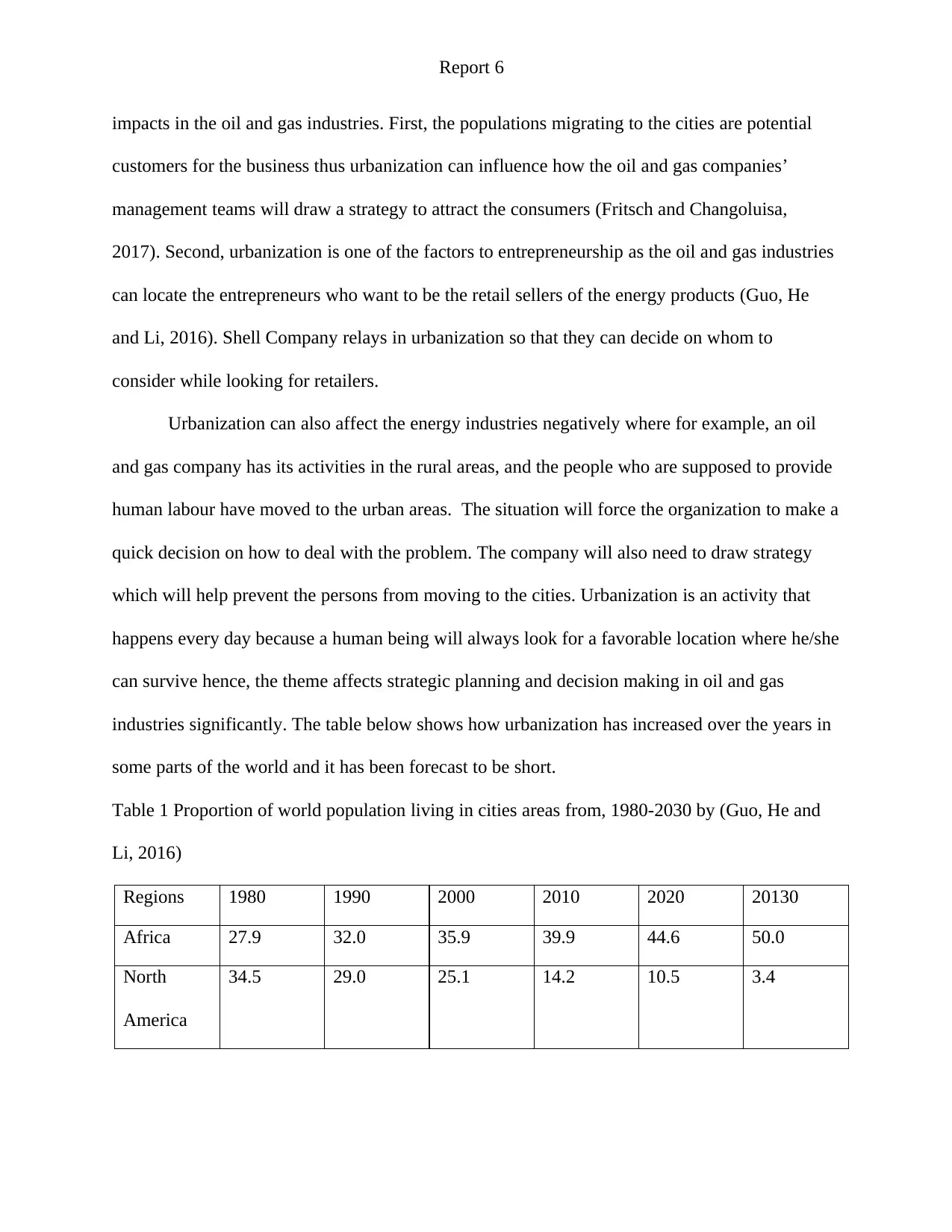
Report 6
impacts in the oil and gas industries. First, the populations migrating to the cities are potential
customers for the business thus urbanization can influence how the oil and gas companies’
management teams will draw a strategy to attract the consumers (Fritsch and Changoluisa,
2017). Second, urbanization is one of the factors to entrepreneurship as the oil and gas industries
can locate the entrepreneurs who want to be the retail sellers of the energy products (Guo, He
and Li, 2016). Shell Company relays in urbanization so that they can decide on whom to
consider while looking for retailers.
Urbanization can also affect the energy industries negatively where for example, an oil
and gas company has its activities in the rural areas, and the people who are supposed to provide
human labour have moved to the urban areas. The situation will force the organization to make a
quick decision on how to deal with the problem. The company will also need to draw strategy
which will help prevent the persons from moving to the cities. Urbanization is an activity that
happens every day because a human being will always look for a favorable location where he/she
can survive hence, the theme affects strategic planning and decision making in oil and gas
industries significantly. The table below shows how urbanization has increased over the years in
some parts of the world and it has been forecast to be short.
Table 1 Proportion of world population living in cities areas from, 1980-2030 by (Guo, He and
Li, 2016)
Regions 1980 1990 2000 2010 2020 20130
Africa 27.9 32.0 35.9 39.9 44.6 50.0
North
America
34.5 29.0 25.1 14.2 10.5 3.4
impacts in the oil and gas industries. First, the populations migrating to the cities are potential
customers for the business thus urbanization can influence how the oil and gas companies’
management teams will draw a strategy to attract the consumers (Fritsch and Changoluisa,
2017). Second, urbanization is one of the factors to entrepreneurship as the oil and gas industries
can locate the entrepreneurs who want to be the retail sellers of the energy products (Guo, He
and Li, 2016). Shell Company relays in urbanization so that they can decide on whom to
consider while looking for retailers.
Urbanization can also affect the energy industries negatively where for example, an oil
and gas company has its activities in the rural areas, and the people who are supposed to provide
human labour have moved to the urban areas. The situation will force the organization to make a
quick decision on how to deal with the problem. The company will also need to draw strategy
which will help prevent the persons from moving to the cities. Urbanization is an activity that
happens every day because a human being will always look for a favorable location where he/she
can survive hence, the theme affects strategic planning and decision making in oil and gas
industries significantly. The table below shows how urbanization has increased over the years in
some parts of the world and it has been forecast to be short.
Table 1 Proportion of world population living in cities areas from, 1980-2030 by (Guo, He and
Li, 2016)
Regions 1980 1990 2000 2010 2020 20130
Africa 27.9 32.0 35.9 39.9 44.6 50.0
North
America
34.5 29.0 25.1 14.2 10.5 3.4
⊘ This is a preview!⊘
Do you want full access?
Subscribe today to unlock all pages.

Trusted by 1+ million students worldwide
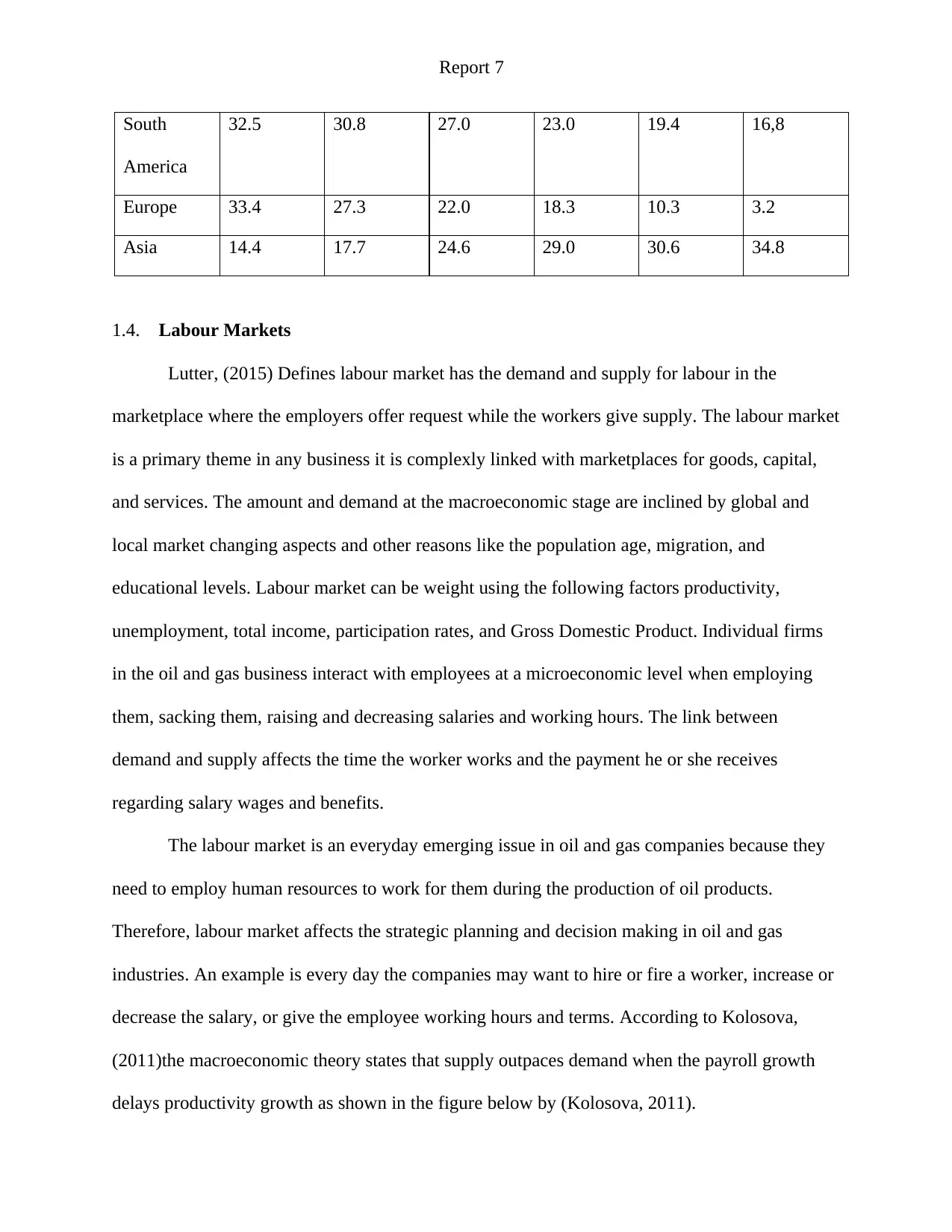
Report 7
South
America
32.5 30.8 27.0 23.0 19.4 16,8
Europe 33.4 27.3 22.0 18.3 10.3 3.2
Asia 14.4 17.7 24.6 29.0 30.6 34.8
1.4. Labour Markets
Lutter, (2015) Defines labour market has the demand and supply for labour in the
marketplace where the employers offer request while the workers give supply. The labour market
is a primary theme in any business it is complexly linked with marketplaces for goods, capital,
and services. The amount and demand at the macroeconomic stage are inclined by global and
local market changing aspects and other reasons like the population age, migration, and
educational levels. Labour market can be weight using the following factors productivity,
unemployment, total income, participation rates, and Gross Domestic Product. Individual firms
in the oil and gas business interact with employees at a microeconomic level when employing
them, sacking them, raising and decreasing salaries and working hours. The link between
demand and supply affects the time the worker works and the payment he or she receives
regarding salary wages and benefits.
The labour market is an everyday emerging issue in oil and gas companies because they
need to employ human resources to work for them during the production of oil products.
Therefore, labour market affects the strategic planning and decision making in oil and gas
industries. An example is every day the companies may want to hire or fire a worker, increase or
decrease the salary, or give the employee working hours and terms. According to Kolosova,
(2011)the macroeconomic theory states that supply outpaces demand when the payroll growth
delays productivity growth as shown in the figure below by (Kolosova, 2011).
South
America
32.5 30.8 27.0 23.0 19.4 16,8
Europe 33.4 27.3 22.0 18.3 10.3 3.2
Asia 14.4 17.7 24.6 29.0 30.6 34.8
1.4. Labour Markets
Lutter, (2015) Defines labour market has the demand and supply for labour in the
marketplace where the employers offer request while the workers give supply. The labour market
is a primary theme in any business it is complexly linked with marketplaces for goods, capital,
and services. The amount and demand at the macroeconomic stage are inclined by global and
local market changing aspects and other reasons like the population age, migration, and
educational levels. Labour market can be weight using the following factors productivity,
unemployment, total income, participation rates, and Gross Domestic Product. Individual firms
in the oil and gas business interact with employees at a microeconomic level when employing
them, sacking them, raising and decreasing salaries and working hours. The link between
demand and supply affects the time the worker works and the payment he or she receives
regarding salary wages and benefits.
The labour market is an everyday emerging issue in oil and gas companies because they
need to employ human resources to work for them during the production of oil products.
Therefore, labour market affects the strategic planning and decision making in oil and gas
industries. An example is every day the companies may want to hire or fire a worker, increase or
decrease the salary, or give the employee working hours and terms. According to Kolosova,
(2011)the macroeconomic theory states that supply outpaces demand when the payroll growth
delays productivity growth as shown in the figure below by (Kolosova, 2011).
Paraphrase This Document
Need a fresh take? Get an instant paraphrase of this document with our AI Paraphraser
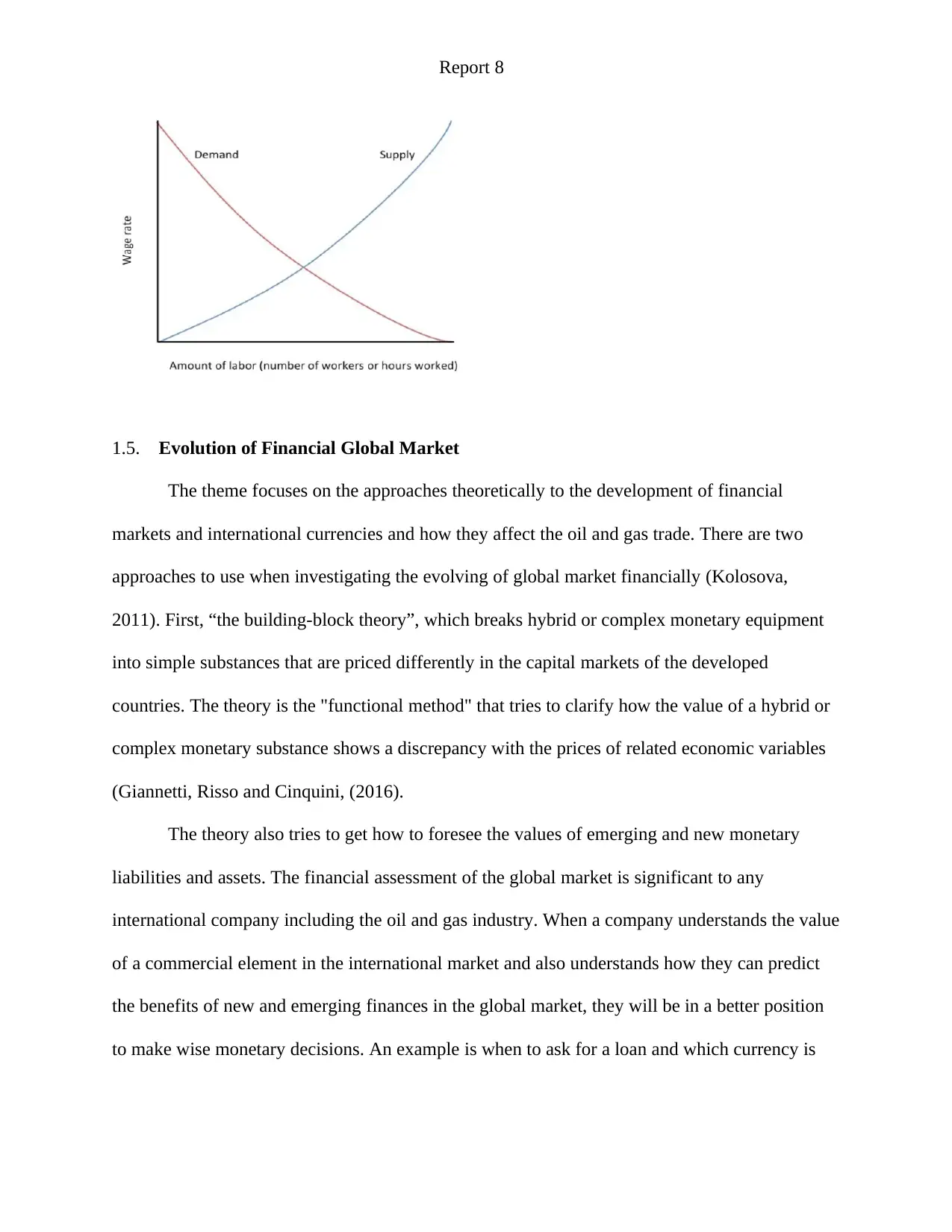
Report 8
1.5. Evolution of Financial Global Market
The theme focuses on the approaches theoretically to the development of financial
markets and international currencies and how they affect the oil and gas trade. There are two
approaches to use when investigating the evolving of global market financially (Kolosova,
2011). First, “the building-block theory”, which breaks hybrid or complex monetary equipment
into simple substances that are priced differently in the capital markets of the developed
countries. The theory is the "functional method" that tries to clarify how the value of a hybrid or
complex monetary substance shows a discrepancy with the prices of related economic variables
(Giannetti, Risso and Cinquini, (2016).
The theory also tries to get how to foresee the values of emerging and new monetary
liabilities and assets. The financial assessment of the global market is significant to any
international company including the oil and gas industry. When a company understands the value
of a commercial element in the international market and also understands how they can predict
the benefits of new and emerging finances in the global market, they will be in a better position
to make wise monetary decisions. An example is when to ask for a loan and which currency is
1.5. Evolution of Financial Global Market
The theme focuses on the approaches theoretically to the development of financial
markets and international currencies and how they affect the oil and gas trade. There are two
approaches to use when investigating the evolving of global market financially (Kolosova,
2011). First, “the building-block theory”, which breaks hybrid or complex monetary equipment
into simple substances that are priced differently in the capital markets of the developed
countries. The theory is the "functional method" that tries to clarify how the value of a hybrid or
complex monetary substance shows a discrepancy with the prices of related economic variables
(Giannetti, Risso and Cinquini, (2016).
The theory also tries to get how to foresee the values of emerging and new monetary
liabilities and assets. The financial assessment of the global market is significant to any
international company including the oil and gas industry. When a company understands the value
of a commercial element in the international market and also understands how they can predict
the benefits of new and emerging finances in the global market, they will be in a better position
to make wise monetary decisions. An example is when to ask for a loan and which currency is
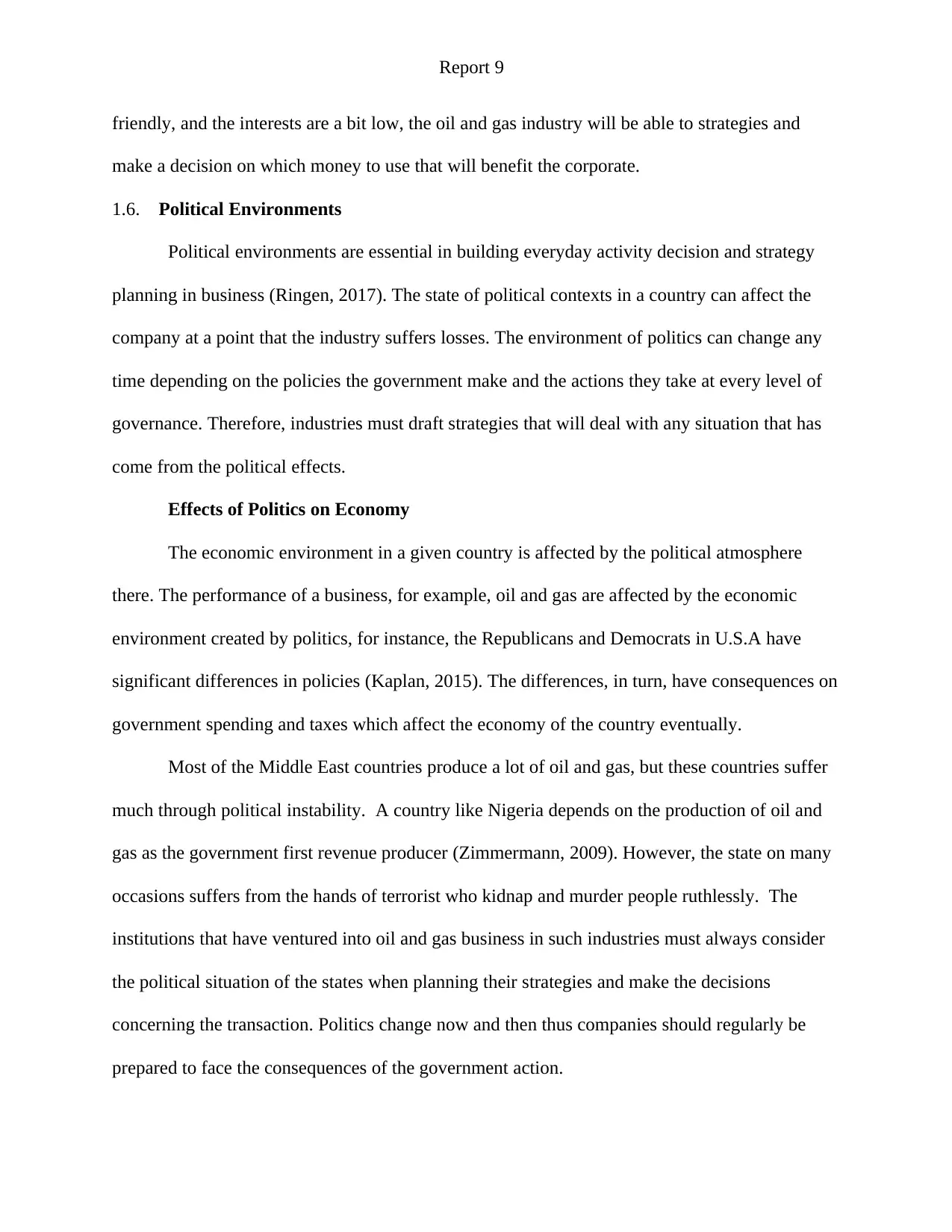
Report 9
friendly, and the interests are a bit low, the oil and gas industry will be able to strategies and
make a decision on which money to use that will benefit the corporate.
1.6. Political Environments
Political environments are essential in building everyday activity decision and strategy
planning in business (Ringen, 2017). The state of political contexts in a country can affect the
company at a point that the industry suffers losses. The environment of politics can change any
time depending on the policies the government make and the actions they take at every level of
governance. Therefore, industries must draft strategies that will deal with any situation that has
come from the political effects.
Effects of Politics on Economy
The economic environment in a given country is affected by the political atmosphere
there. The performance of a business, for example, oil and gas are affected by the economic
environment created by politics, for instance, the Republicans and Democrats in U.S.A have
significant differences in policies (Kaplan, 2015). The differences, in turn, have consequences on
government spending and taxes which affect the economy of the country eventually.
Most of the Middle East countries produce a lot of oil and gas, but these countries suffer
much through political instability. A country like Nigeria depends on the production of oil and
gas as the government first revenue producer (Zimmermann, 2009). However, the state on many
occasions suffers from the hands of terrorist who kidnap and murder people ruthlessly. The
institutions that have ventured into oil and gas business in such industries must always consider
the political situation of the states when planning their strategies and make the decisions
concerning the transaction. Politics change now and then thus companies should regularly be
prepared to face the consequences of the government action.
friendly, and the interests are a bit low, the oil and gas industry will be able to strategies and
make a decision on which money to use that will benefit the corporate.
1.6. Political Environments
Political environments are essential in building everyday activity decision and strategy
planning in business (Ringen, 2017). The state of political contexts in a country can affect the
company at a point that the industry suffers losses. The environment of politics can change any
time depending on the policies the government make and the actions they take at every level of
governance. Therefore, industries must draft strategies that will deal with any situation that has
come from the political effects.
Effects of Politics on Economy
The economic environment in a given country is affected by the political atmosphere
there. The performance of a business, for example, oil and gas are affected by the economic
environment created by politics, for instance, the Republicans and Democrats in U.S.A have
significant differences in policies (Kaplan, 2015). The differences, in turn, have consequences on
government spending and taxes which affect the economy of the country eventually.
Most of the Middle East countries produce a lot of oil and gas, but these countries suffer
much through political instability. A country like Nigeria depends on the production of oil and
gas as the government first revenue producer (Zimmermann, 2009). However, the state on many
occasions suffers from the hands of terrorist who kidnap and murder people ruthlessly. The
institutions that have ventured into oil and gas business in such industries must always consider
the political situation of the states when planning their strategies and make the decisions
concerning the transaction. Politics change now and then thus companies should regularly be
prepared to face the consequences of the government action.
⊘ This is a preview!⊘
Do you want full access?
Subscribe today to unlock all pages.

Trusted by 1+ million students worldwide
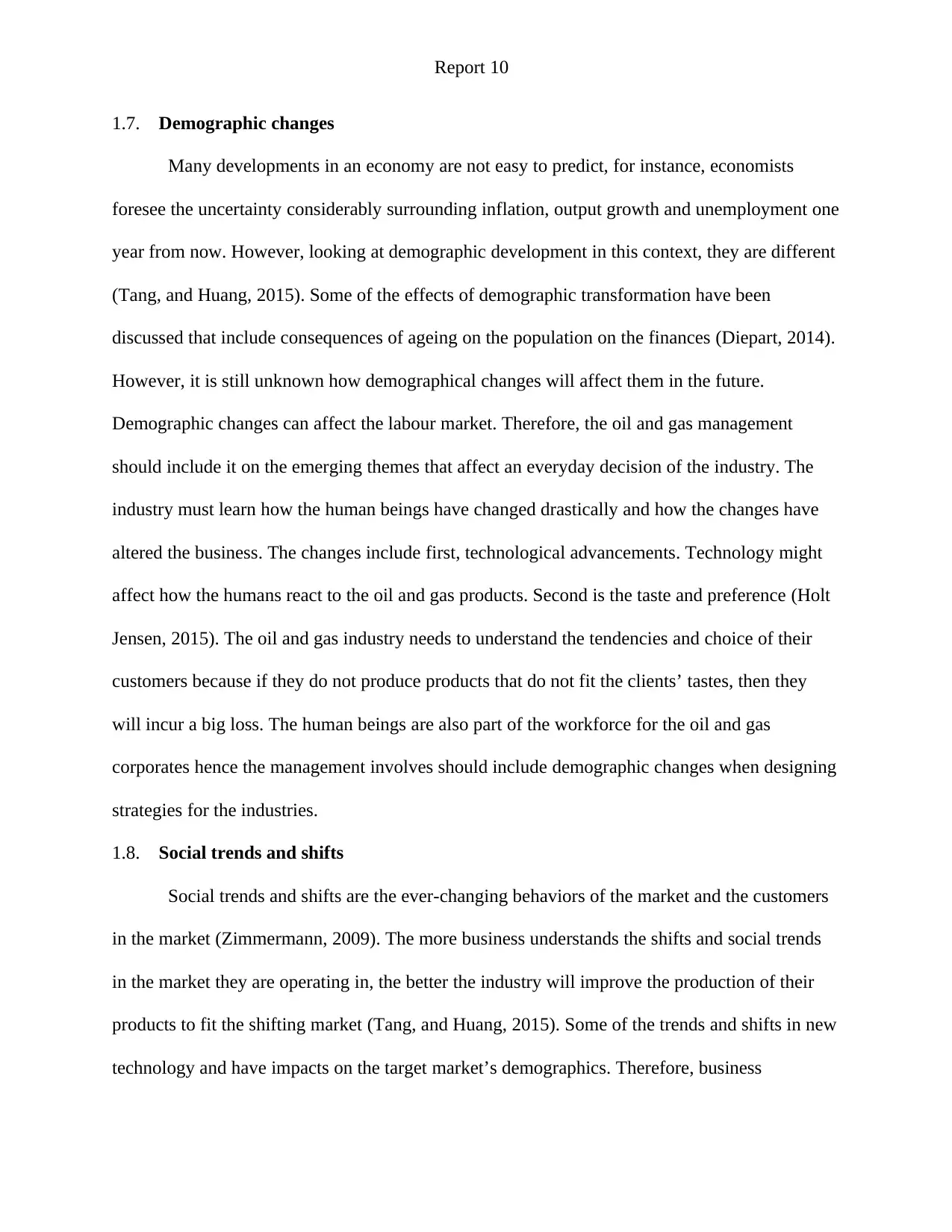
Report 10
1.7. Demographic changes
Many developments in an economy are not easy to predict, for instance, economists
foresee the uncertainty considerably surrounding inflation, output growth and unemployment one
year from now. However, looking at demographic development in this context, they are different
(Tang, and Huang, 2015). Some of the effects of demographic transformation have been
discussed that include consequences of ageing on the population on the finances (Diepart, 2014).
However, it is still unknown how demographical changes will affect them in the future.
Demographic changes can affect the labour market. Therefore, the oil and gas management
should include it on the emerging themes that affect an everyday decision of the industry. The
industry must learn how the human beings have changed drastically and how the changes have
altered the business. The changes include first, technological advancements. Technology might
affect how the humans react to the oil and gas products. Second is the taste and preference (Holt
Jensen, 2015). The oil and gas industry needs to understand the tendencies and choice of their
customers because if they do not produce products that do not fit the clients’ tastes, then they
will incur a big loss. The human beings are also part of the workforce for the oil and gas
corporates hence the management involves should include demographic changes when designing
strategies for the industries.
1.8. Social trends and shifts
Social trends and shifts are the ever-changing behaviors of the market and the customers
in the market (Zimmermann, 2009). The more business understands the shifts and social trends
in the market they are operating in, the better the industry will improve the production of their
products to fit the shifting market (Tang, and Huang, 2015). Some of the trends and shifts in new
technology and have impacts on the target market’s demographics. Therefore, business
1.7. Demographic changes
Many developments in an economy are not easy to predict, for instance, economists
foresee the uncertainty considerably surrounding inflation, output growth and unemployment one
year from now. However, looking at demographic development in this context, they are different
(Tang, and Huang, 2015). Some of the effects of demographic transformation have been
discussed that include consequences of ageing on the population on the finances (Diepart, 2014).
However, it is still unknown how demographical changes will affect them in the future.
Demographic changes can affect the labour market. Therefore, the oil and gas management
should include it on the emerging themes that affect an everyday decision of the industry. The
industry must learn how the human beings have changed drastically and how the changes have
altered the business. The changes include first, technological advancements. Technology might
affect how the humans react to the oil and gas products. Second is the taste and preference (Holt
Jensen, 2015). The oil and gas industry needs to understand the tendencies and choice of their
customers because if they do not produce products that do not fit the clients’ tastes, then they
will incur a big loss. The human beings are also part of the workforce for the oil and gas
corporates hence the management involves should include demographic changes when designing
strategies for the industries.
1.8. Social trends and shifts
Social trends and shifts are the ever-changing behaviors of the market and the customers
in the market (Zimmermann, 2009). The more business understands the shifts and social trends
in the market they are operating in, the better the industry will improve the production of their
products to fit the shifting market (Tang, and Huang, 2015). Some of the trends and shifts in new
technology and have impacts on the target market’s demographics. Therefore, business
Paraphrase This Document
Need a fresh take? Get an instant paraphrase of this document with our AI Paraphraser
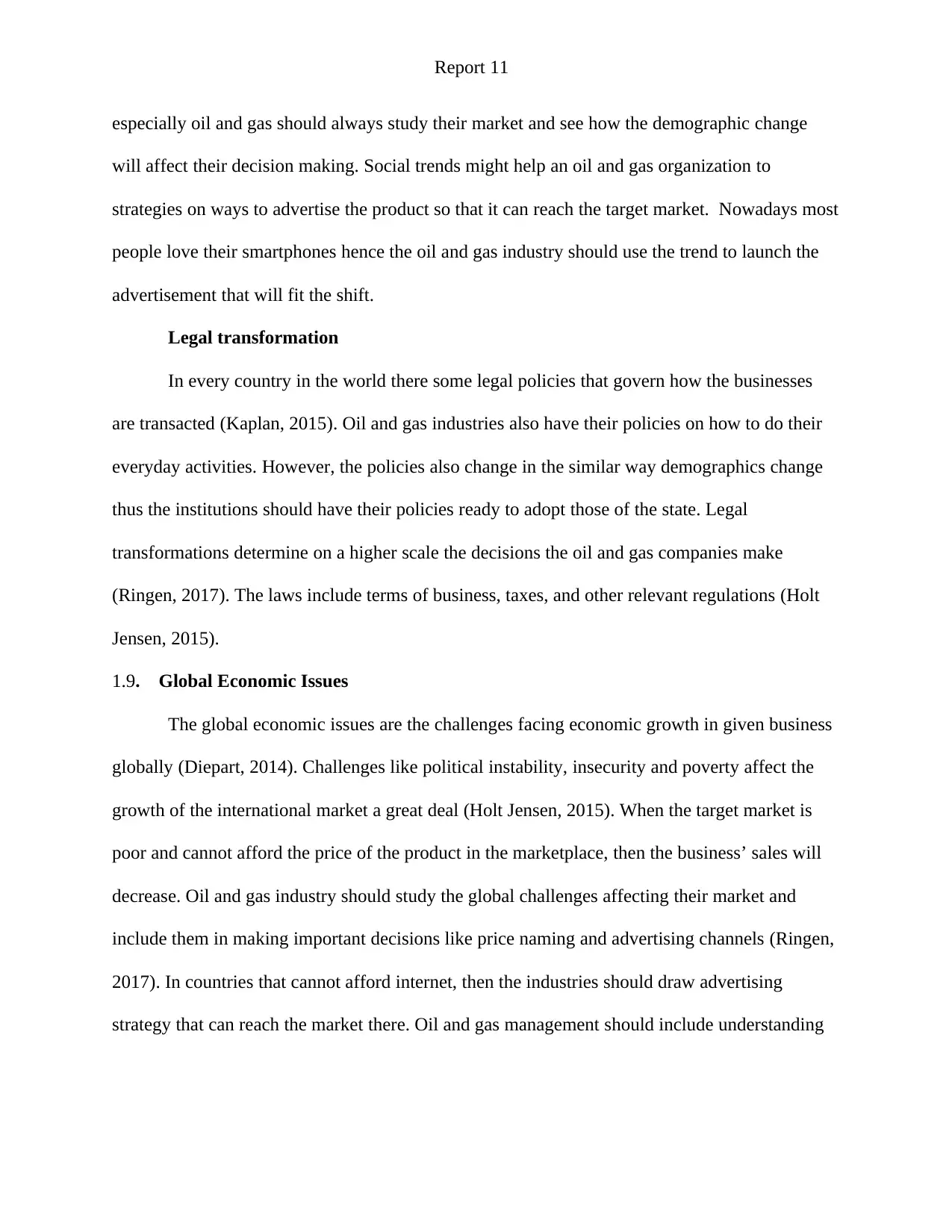
Report 11
especially oil and gas should always study their market and see how the demographic change
will affect their decision making. Social trends might help an oil and gas organization to
strategies on ways to advertise the product so that it can reach the target market. Nowadays most
people love their smartphones hence the oil and gas industry should use the trend to launch the
advertisement that will fit the shift.
Legal transformation
In every country in the world there some legal policies that govern how the businesses
are transacted (Kaplan, 2015). Oil and gas industries also have their policies on how to do their
everyday activities. However, the policies also change in the similar way demographics change
thus the institutions should have their policies ready to adopt those of the state. Legal
transformations determine on a higher scale the decisions the oil and gas companies make
(Ringen, 2017). The laws include terms of business, taxes, and other relevant regulations (Holt
Jensen, 2015).
1.9. Global Economic Issues
The global economic issues are the challenges facing economic growth in given business
globally (Diepart, 2014). Challenges like political instability, insecurity and poverty affect the
growth of the international market a great deal (Holt Jensen, 2015). When the target market is
poor and cannot afford the price of the product in the marketplace, then the business’ sales will
decrease. Oil and gas industry should study the global challenges affecting their market and
include them in making important decisions like price naming and advertising channels (Ringen,
2017). In countries that cannot afford internet, then the industries should draw advertising
strategy that can reach the market there. Oil and gas management should include understanding
especially oil and gas should always study their market and see how the demographic change
will affect their decision making. Social trends might help an oil and gas organization to
strategies on ways to advertise the product so that it can reach the target market. Nowadays most
people love their smartphones hence the oil and gas industry should use the trend to launch the
advertisement that will fit the shift.
Legal transformation
In every country in the world there some legal policies that govern how the businesses
are transacted (Kaplan, 2015). Oil and gas industries also have their policies on how to do their
everyday activities. However, the policies also change in the similar way demographics change
thus the institutions should have their policies ready to adopt those of the state. Legal
transformations determine on a higher scale the decisions the oil and gas companies make
(Ringen, 2017). The laws include terms of business, taxes, and other relevant regulations (Holt
Jensen, 2015).
1.9. Global Economic Issues
The global economic issues are the challenges facing economic growth in given business
globally (Diepart, 2014). Challenges like political instability, insecurity and poverty affect the
growth of the international market a great deal (Holt Jensen, 2015). When the target market is
poor and cannot afford the price of the product in the marketplace, then the business’ sales will
decrease. Oil and gas industry should study the global challenges affecting their market and
include them in making important decisions like price naming and advertising channels (Ringen,
2017). In countries that cannot afford internet, then the industries should draw advertising
strategy that can reach the market there. Oil and gas management should include understanding
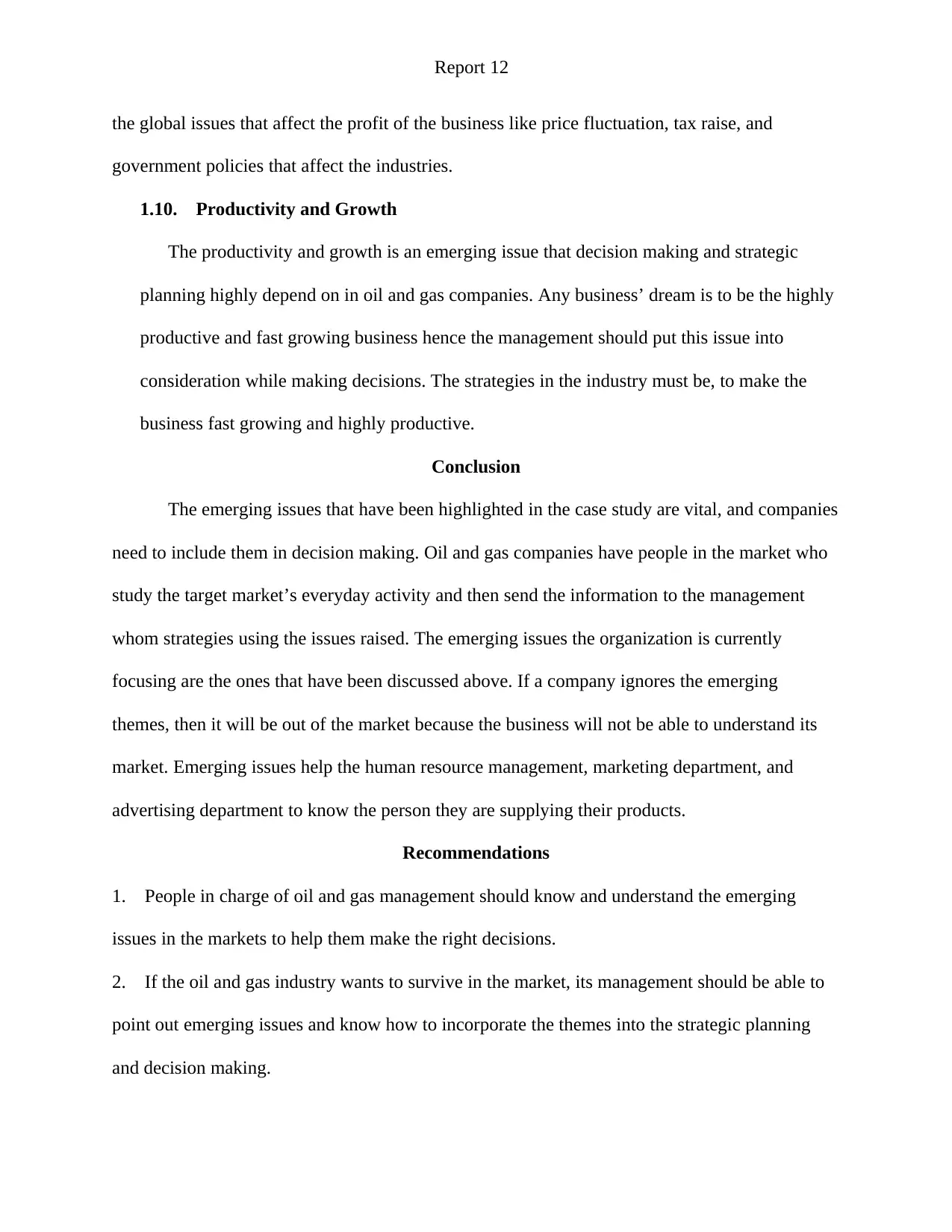
Report 12
the global issues that affect the profit of the business like price fluctuation, tax raise, and
government policies that affect the industries.
1.10. Productivity and Growth
The productivity and growth is an emerging issue that decision making and strategic
planning highly depend on in oil and gas companies. Any business’ dream is to be the highly
productive and fast growing business hence the management should put this issue into
consideration while making decisions. The strategies in the industry must be, to make the
business fast growing and highly productive.
Conclusion
The emerging issues that have been highlighted in the case study are vital, and companies
need to include them in decision making. Oil and gas companies have people in the market who
study the target market’s everyday activity and then send the information to the management
whom strategies using the issues raised. The emerging issues the organization is currently
focusing are the ones that have been discussed above. If a company ignores the emerging
themes, then it will be out of the market because the business will not be able to understand its
market. Emerging issues help the human resource management, marketing department, and
advertising department to know the person they are supplying their products.
Recommendations
1. People in charge of oil and gas management should know and understand the emerging
issues in the markets to help them make the right decisions.
2. If the oil and gas industry wants to survive in the market, its management should be able to
point out emerging issues and know how to incorporate the themes into the strategic planning
and decision making.
the global issues that affect the profit of the business like price fluctuation, tax raise, and
government policies that affect the industries.
1.10. Productivity and Growth
The productivity and growth is an emerging issue that decision making and strategic
planning highly depend on in oil and gas companies. Any business’ dream is to be the highly
productive and fast growing business hence the management should put this issue into
consideration while making decisions. The strategies in the industry must be, to make the
business fast growing and highly productive.
Conclusion
The emerging issues that have been highlighted in the case study are vital, and companies
need to include them in decision making. Oil and gas companies have people in the market who
study the target market’s everyday activity and then send the information to the management
whom strategies using the issues raised. The emerging issues the organization is currently
focusing are the ones that have been discussed above. If a company ignores the emerging
themes, then it will be out of the market because the business will not be able to understand its
market. Emerging issues help the human resource management, marketing department, and
advertising department to know the person they are supplying their products.
Recommendations
1. People in charge of oil and gas management should know and understand the emerging
issues in the markets to help them make the right decisions.
2. If the oil and gas industry wants to survive in the market, its management should be able to
point out emerging issues and know how to incorporate the themes into the strategic planning
and decision making.
⊘ This is a preview!⊘
Do you want full access?
Subscribe today to unlock all pages.

Trusted by 1+ million students worldwide
1 out of 15
Related Documents
Your All-in-One AI-Powered Toolkit for Academic Success.
+13062052269
info@desklib.com
Available 24*7 on WhatsApp / Email
![[object Object]](/_next/static/media/star-bottom.7253800d.svg)
Unlock your academic potential
Copyright © 2020–2025 A2Z Services. All Rights Reserved. Developed and managed by ZUCOL.




